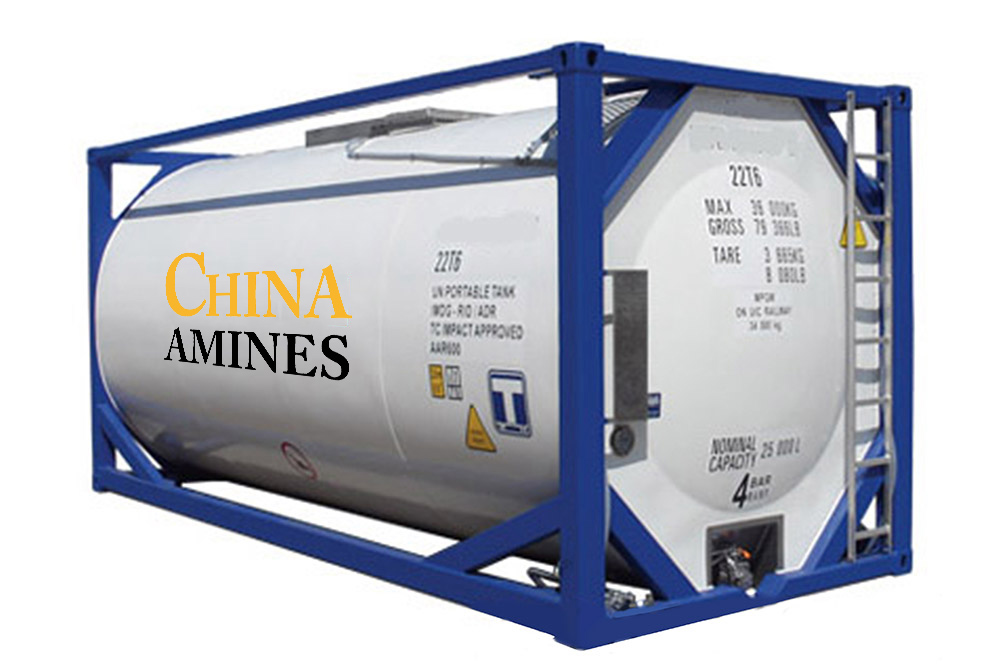Your Questions and Comments
Your sales and customer service desk partners within China Amines Co will continue to serve you. You can also contact us via our headquarter office-
Email:info@chinaamines.com
China Amines Co
Product Profile
1. Chemical Structure and Properties
Molecular Formula:
C₆H₁₅N
Structural Formula:
N(CH₂CH₃)₃
A tertiary amine composed of a central nitrogen atom bonded to three ethyl groups.
Physical Properties:
- State: Colorless liquid with a strong, ammonia-like odor.
- Boiling Point: 89°C; Density: 0.73 g/cm³; Vapor Pressure: 54 mmHg at 20°C.
- Solubility: Miscible with organic solvents (e.g., ethanol, ether); slightly soluble in water (1.2 g/100 mL).
Chemical Properties:
- Basicity: Strong base (pKa = 10.75 in water), reacts exothermically with acids to form salts (e.g., triethylamine hydrochloride).
- Reactivity: Participates in nucleophilic substitutions and catalytic reactions; flammable (flash point: -7°C).
2. Industrial Applications
Chemical Synthesis:
- Catalyst: Widely used in polyurethane foam production to accelerate isocyanate-polyol reactions.
- Neutralizing Agent: Neutralizes acids in pharmaceutical synthesis (e.g., penicillin production).
Pharmaceuticals:
- Intermediate for antimalarials (e.g., chloroquine) and local anesthetics (e.g., lidocaine).
Agrochemicals:
- Key component in herbicide formulations (e.g., glyphosate stabilization).
Polymer Industry:
- Acts as a chain extender in epoxy resin curing and silicone rubber production.
Electronics:
- Etching agent in semiconductor manufacturing for silicon wafer processing.
3. Safety and Toxicology
Hazard Profile:
- Inhalation (≥25 ppm): Irritates respiratory tract, causes headache, dizziness (TLV-TWA: 1 ppm).
- Skin/Eye Contact: Severe irritation and chemical burns (rabbit skin LD50: 460 mg/kg).
- Ingestion: Highly toxic (oral LD50 rat: 460 mg/kg); induces gastrointestinal damage.
Acute Exposure:
- Chronic Effects: Potential liver/kidney toxicity (animal studies).
Flammability:
Highly flammable liquid (NFPA 704: Health 3, Flammability 3).
Protection Protocols:
- Engineering Controls: Explosion-proof ventilation, vapor detectors.
- PPE: Chemical-resistant gloves (e.g., neoprene), goggles, and respirators with organic vapor cartridges.
Regulatory Limits:
OSHA PEL: 25 ppm (8-hour TWA); NIOSH IDLH: 200 ppm.
4. Environmental and Regulatory Compliance
Ecotoxicology:
- Aquatic Toxicity: LC50 (fish, 96h): 12 mg/L; EC50 (daphnia): 8 mg/L.
- Biodegradation: Moderate (60% degradation in 28 days, OECD 301B).
- Atmospheric Impact: Reacts with ozone to form secondary pollutants (half-life ~6 hours).
Global Regulations:
- EU: Classified as Flammable Liquid (Category 2) and Acute Tox. 3 (H331) under CLP.
- US EPA: Listed on the Toxic Release Inventory (TRI); regulated under CERCLA.
- China: GB 13690-2009 categorizes TEA as a Class 3.2 flammable liquid.
Transport:
UN 1296; Class 3 (Flammable Liquid), Packing Group II.
5. Case Studies and Application Insights
Case 1: Polyurethane Foam Production
Process: Dow Chemical uses TEA as a catalyst in flexible foam manufacturing for mattresses.
Efficiency: Reduces curing time by 40% vs. non-catalytic methods.
Case 2: Pharmaceutical Neutralization
Application: Pfizer employs TEA to neutralize HCl during ciprofloxacin synthesis, achieving 98% yield.
Comparative Analysis:
- Cost: TEA is 30% cheaper but requires stricter odor control.
- Performance: Pyridine offers lower flammability but higher toxicity (TLV: 0.1 ppm).


